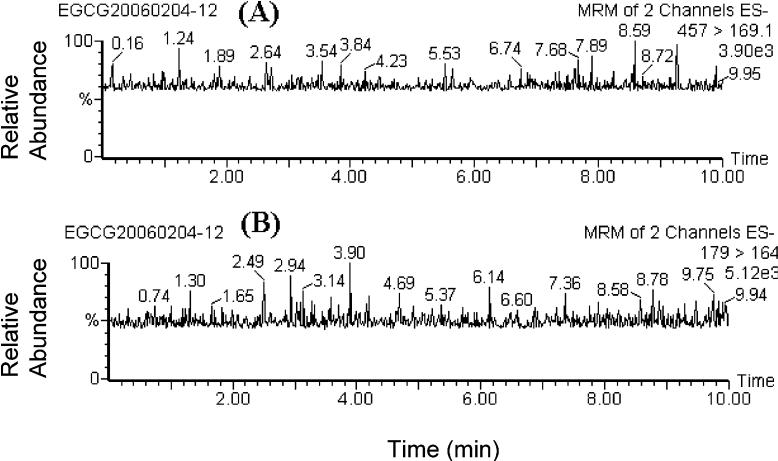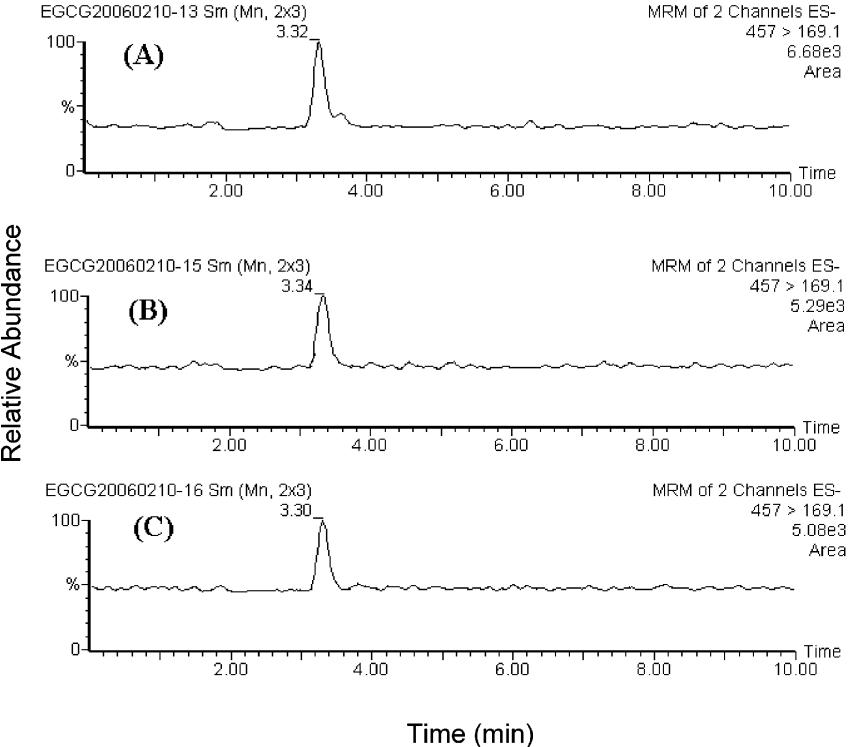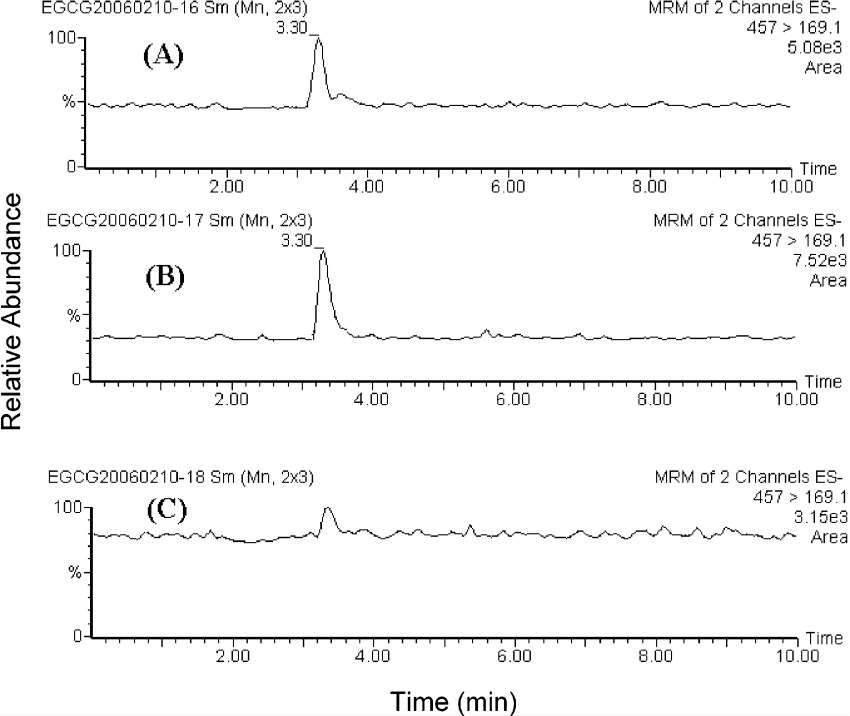What is Epigallocatechin?
Epigallocatechin (EGC), is a type of natural phenol and antioxidant that belongs to catechin class. Predominantly present in green tea, it constitutes the second-most abundant catechin in this healthy beverage. Epigallocatechin and its derivatives exhibit a unique chemical framework of two aromatic rings (the A and B rings) interconnected by an oxygen-bridged 3-carbon chain, arranged into a dihydropyran heterocyclic ring (referred as the C-ring).
This molecular layout imbues epigallocatechin with powerful antioxidant potential due to the large number of hydroxyl groups, which can donate electrons and neutralize free radicals—volatile particles known to inflict cellular damage.
Why is Epigallocatechin Analysis Necessary?
Epigallocatechin is more than just an antioxidant; its unique interactions with biomolecules within the human body, attributed to its aromatic rings, make it a powerful bioactive compound. Our EGC analysis goes beyond the surface, providing a comprehensive understanding of its properties and potential impacts on various physiological responses.
Key Insights from EGC Analysis:
- Health and Wellness Applications: For health and wellness companies, EGC analysis is indispensable. By delving into the compound's composition, we help ensure the production of safe, high-quality nutraceuticals. Understanding EGC assists in mitigating potential negative effects, fostering the creation of products that prioritize consumer well-being.
- Pharmaceutical Advancements: Pharmaceutical companies benefit significantly from our EGC analysis services. Identification of critical properties empowers these companies to design safer and more effective drugs targeting a spectrum of health ailments. Our insights contribute to the development of pharmaceutical interventions that leverage the therapeutic potential of EGC.
Creative Proteomics utilizes a bioanalytical strategy that is enriched by our expertise and technological architecture. Our services include qualitative and quantitative analysis of epigallocatechin, covering structural analysis, purity checks, sample analysis, and therapeutic potential evaluation.
Specific Project Offered by Creative Proteomics in Epigallocatechin Analysis
Comprehensive Epigallocatechin Analysis: This direction offers a thorough examination of epigallocatechin, focusing on in-depth identification, quantification, and characterization. Our top priorities are reliability and accuracy to ensure a comprehensive understanding of the compound.
Targeted Epigallocatechin Analysis: This project focuses on the targeted analysis of pre-selected Epigallocatechin. Tailored to your specific needs, it ensures efficient and detailed research with a personalized touch.
Comparative Epigallocatechin Analysis: This project involves relative comparisons of Epigallocatechin in different samples, exploring contexts such as diseased vs. healthy or treated vs. untreated. The goal is to provide insightful comparisons for a nuanced understanding.
Epigallocatechin Metabolism Study: Aiming to comprehend epigallocatechin's metabolism, this project direction delves into bio-transformations or chemical modifications within biological systems. The focus is on understanding how epigallocatechin interacts within the body.
Epigallocatechin Drug-Interactions Analysis: Critical for pharmaceutical research, this direction analyzes the drug-interactions of epigallocatechin, offering crucial insights into its pharmacokinetics and pharmacodynamics. This analysis is pivotal for understanding its role in potential drug formulations.
Epigallocatechin Analysis Techniques
LC-MS for EGC Analysis: Our LC-MS technique combines liquid chromatography with the Agilent 6490 Triple Quadrupole Mass Spectrometer, ensuring precise quantification by isolating Epigallocatechin from other catechins in complex samples.
GC-MS Advancements: Utilizing Agilent GC-MS systems, our facility employs GC-MS as a simultaneous identification and quantification tool, enhancing the depth of Epigallocatechin analysis. This allows identification not only of EGC but also potential derivatives or metabolites, enriching the overall analysis.
MS/MS with Waters SYNAPT Series: Tandem Mass Spectrometry, powered by the Waters SYNAPT series, facilitates advanced EGC analysis. Through the coupling of mass analyzers with an additional reaction step, this technique enhances our ability to dissect EGC's composition, especially in complex matrices.
HPLC Precision: For pivotal Epigallocatechin analysis, HPLC coupled with photodiode array detection using the Shimadzu HPLC system ensures accurate quantification in dietary supplements and tea samples. This setup provides robust results meeting the highest standards of accuracy.
 Workflow for Plant Metabolomics Service
Workflow for Plant Metabolomics Service
List of Epigallocatechin Analyzed (including but not limited to)
| Epigallocatechin |
Epigallocatechin gallate (EGCG) |
Epicatechin (EC) |
Epicatechin gallate (ECG) |
| Epigallocatechin-3-O-gallate |
Gallocatechin gallate (GCG) |
Epicatechin-3-gallate |
Catechin |
Sample Requirements for Epigallocatechin Assay
| Sample Type |
Sample Volume |
Description |
| Green Tea Extract |
1 mL |
Extract from green tea containing Epigallocatechin |
| Serum/Plasma |
100 µL |
Serum or plasma samples for biological matrices |
| Tissue Homogenate |
50 mg |
Homogenized tissue samples for comprehensive analysis |
| Dietary Supplements |
1-2 capsules or 1 g powder |
Capsules, powders, or liquid forms for QC testing |
| Plant Extracts |
1 mL |
Extracts from other plant sources for comparison |
| Cell Culture Medium |
1 mL |
Medium from in vitro studies for cellular response |
| Urine |
100 µL - 1 mL |
Urine samples for assessing metabolic excretion |
Case. Pharmacokinetic Study of (-)-Epigallocatechin-3-gallate (EGCG) in Freely Moving Rats
Background
(-)-Epigallocatechin-3-gallate (EGCG), a major polyphenol in green tea, exhibits diverse pharmacological effects, including antioxidant and anticancer activities. Despite its significance, accurate pharmacokinetic information, especially in freely moving rats and brain distribution profiles, remains scarce.
Sample
Commercial Taiwanese Woo-Long tea served as the source for EGCG extraction. The study involved male specific pathogen-free Sprague-Dawley rats, weighing 280-320 g, with surgically implanted cannulae in the jugular and femoral veins for blood sampling and drug administration.
Technical Platform and Procedure
Characterization of EGCG: Physicochemical properties, IR, and NMR spectroscopy were employed for EGCG characterization, revealing a catechol structure with distinct phenolic groups.
Analytical Method (LC-MS/MS): A validated LC-MS/MS method with an automated blood sampling system was developed to measure EGCG in rat plasma. Full-scan mass spectra and MRM were used for identification and quantification, respectively. The addition of acetic acid enhanced signal intensity.
Method Validation: Calibration curves demonstrated linearity over the range of 5-5000 ng/mL, with a lower limit of quantification (LLOQ) at 5 ng/mL. Intra- and interassay precision and accuracy values were within acceptable limits.
Protein Binding: EGCG's protein binding in rat plasma was assessed, indicating a high binding ratio of 92.4%.
Brain Regional Distribution: EGCG concentrations in various brain regions were determined, suggesting challenges in brain distribution potentially linked to its bipolar functional group and protein binding.
Results
Characterization of EGCG revealed a brown amorphous powder with specific IR and NMR spectra, confirming its structural attributes.
The LC-MS/MS method exhibited clean chromatograms with high sensitivity, allowing for accurate EGCG quantification.
Method validation demonstrated the reliability of the assay with excellent linearity, precision, and accuracy.
EGCG's protein binding in rat plasma was notably high at 92.4%, emphasizing its potential impact on herb-drug interactions.
Brain distribution studies indicated EGCG detection in various brain regions, with concentrations around the lower limit of quantification, suggesting challenges in brain permeability.
 LC−tandem mass chromatogram showing the drug-free plasma extract with MRM: (A) the mass transitions were m/z 457f169 for EGCG and (B) m/z 187f164 for the internal standard (theophylline).
LC−tandem mass chromatogram showing the drug-free plasma extract with MRM: (A) the mass transitions were m/z 457f169 for EGCG and (B) m/z 187f164 for the internal standard (theophylline).
 Representative MRM chromatogram showing EGCG in rat brain tissues at 15 min after EGCG administration (50 mg/kg, iv): (A) cortex; (B) brain stem; (C) hippocampus.
Representative MRM chromatogram showing EGCG in rat brain tissues at 15 min after EGCG administration (50 mg/kg, iv): (A) cortex; (B) brain stem; (C) hippocampus.
 Representative MRM chromatogram showing EGCG in rat brain tissues at 15 min after EGCG administration (50 mg/kg, iv): (A) striatum; (B) cerebellum; (C) the rest of the brain.
Representative MRM chromatogram showing EGCG in rat brain tissues at 15 min after EGCG administration (50 mg/kg, iv): (A) striatum; (B) cerebellum; (C) the rest of the brain.
Reference
- Lin, Lei-Chwen, et al. "Pharmacokinetics of (−)-epigallocatechin-3-gallate in conscious and freely moving rats and its brain regional distribution." Journal of agricultural and food chemistry 55.4 (2007): 1517-1524.


 Workflow for Plant Metabolomics Service
Workflow for Plant Metabolomics Service LC−tandem mass chromatogram showing the drug-free plasma extract with MRM: (A) the mass transitions were m/z 457f169 for EGCG and (B) m/z 187f164 for the internal standard (theophylline).
LC−tandem mass chromatogram showing the drug-free plasma extract with MRM: (A) the mass transitions were m/z 457f169 for EGCG and (B) m/z 187f164 for the internal standard (theophylline). Representative MRM chromatogram showing EGCG in rat brain tissues at 15 min after EGCG administration (50 mg/kg, iv): (A) cortex; (B) brain stem; (C) hippocampus.
Representative MRM chromatogram showing EGCG in rat brain tissues at 15 min after EGCG administration (50 mg/kg, iv): (A) cortex; (B) brain stem; (C) hippocampus. Representative MRM chromatogram showing EGCG in rat brain tissues at 15 min after EGCG administration (50 mg/kg, iv): (A) striatum; (B) cerebellum; (C) the rest of the brain.
Representative MRM chromatogram showing EGCG in rat brain tissues at 15 min after EGCG administration (50 mg/kg, iv): (A) striatum; (B) cerebellum; (C) the rest of the brain.

